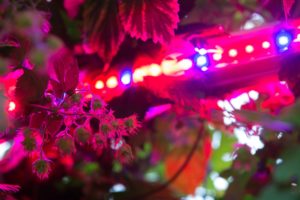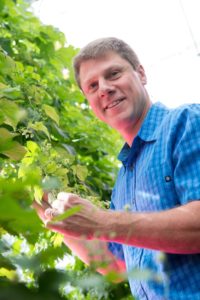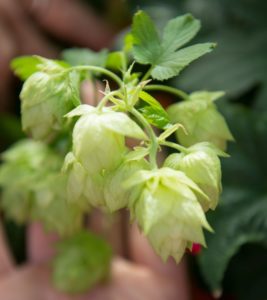CSU Professor of Horticulture hoppy to help Colorado breweries
by Jennifer Dimas | June 20, 2016 10:32 AM
The summer solstice is upon us and plants are happily soaking up the maximum amount of sunlight on the longest day of the year. Inside the Colorado State University Horticulture Center, however, plants don’t know the difference between the summer solstice and the winter solstice – especially the hops.
Unique in the United States

A collaborative partnership with Philips Lighting[1] allows Bill Bauerle, professor of Horticulture and Landscape Architecture[2] at CSU, to produce and harvest hops five times a year — something unique in the United States.
“This is the only location in the United States that is able to produce the product five times a year,” said Bauerle.
CSU’s Horticulture Center is one of the only growing facilities in the country using the specialized Philips Horticulture LED Solutions lighting, which supports a much quicker growing cycle.
“I had the idea to grow hops in our new facility,” said Bauerle. “The timing was right because the new Horticulture Center provided a high-class facility to work in. Additionally, the partnership with Philips added the LED lighting, allowing for year-round production. With those two components available to me, I had the tools to grow them in a controlled environment and I could now extend the growing season to get multiple production cycles.”

Napa Valley of craft beers
The availability of wet — or freshly picked — hops in an area of the country known as the Napa Valley of craft beers will provide a significant benefit to area breweries.
“It’s unheard of to have fresh hops this time of year,” said Bauerle. “They’re normally not available until August or September. This allows brewers to make those wet-hop beers five times a year, whereas the harvest normally only occurred once a year.”
Over 75 percent of U.S. hop production takes place in the state of Washington, with Oregon and Idaho accounting for most of the remaining harvest. Colorado ranks seventh in the country for hops production, with only about 150 acres dedicated to the crop; High Hops Farm in Windsor covers 2.5 acres.
A quality, local product
“There was demand from the local brewers,” said Bauerle. “They wanted a quality, local product. So that was another driving factor to develop multiple-cycle hop production at the Horticulture Center.”

With wet hops normally available one time a year, their transportation makes up a good percentage of UPS’s business during the month of August while the freshly harvested product is delivered to locations across the country.
“That’s why Octoberfest was created, because that’s the time of year that hops are harvested and the fresh hopped beer is finally ready in October,” Bauerle explained.
Revolutionizing hop production
Bauerle is now working with CSU graduate students to test how the specialized lighting affects the yield and the flavor profile characteristics of the hops.
“We have an individual nutrient injector where we can separate out the nutrients and actually affect the flavor of the hops,” said Bauerle.
Brewery executives have already visited CSU’s Horticulture Center to view the operation and are very excited about the prospect of high quality hops grown locally.
“I’m going to work on this for the remainder of my career to revolutionize hop production. We’re looking for funding to do that,” said Bauerle. “I did my graduate work on the East Coast and one of the reasons I came to Colorado was that I fell in love with the beer here, so I always hoped to come back one day, and I finally did. I love craft beer and so the work I’m doing now was a natural fit.”
- collaborative partnership with Philips Lighting: http://source.colostate.edu/philips-partnership-lights-the-way-for-new-research-and-innovation-at-csu/
- Horticulture and Landscape Architecture: http://hortla.agsci.colostate.edu/
Source URL: https://source.colostate.edu/csu-professor-of-horticulture-hoppy-to-help-colorado-breweries/
Copyright ©2024 SOURCE unless otherwise noted.